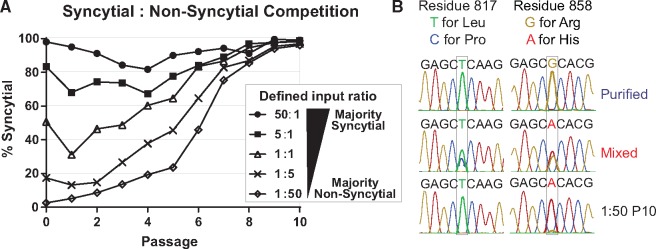Figure 7.
Defined mixtures of purified syncytial and non-syncytial HSV-1 populations reveal a universal advantage of the syncytial phenotype during sequential passage in Vero cells. (A) Purified populations of HSV-1 that displayed a uniformly syncytial or non-syncytial phenotype were mixed in defined ratios (as shown in legend) and allowed to compete during sequential passages of infection on Vero cells. At each passage, the plaque morphology of the resulting viral population was counted and plotted as the percentage of total plaques that were syncytial. MOI (0.01) and time to harvest (72 hpi) of each passage are the same as the initial in vitro evolution experiment described in Figure 1. (B) The tail region of gB (encoded by UL27) that contains the L817P and R858H variants described in Figure 6 was Sanger sequenced from each purified starting population, the Mixed P10 population, and the 1:5 and 1:50 passage 10 (P10) populations. Representative traces are shown with the key nucleic acids highlighted, for the non-syncytial stocks (e.g., Purified), for the mixed population (e.g., Mixed), and for the syncytial stocks (shown here is 1:50 P10; similar data for purified syncytial and 1:5 P10 are not shown). Note that these reads are the reverse-complement of those shown in Figure 6.

